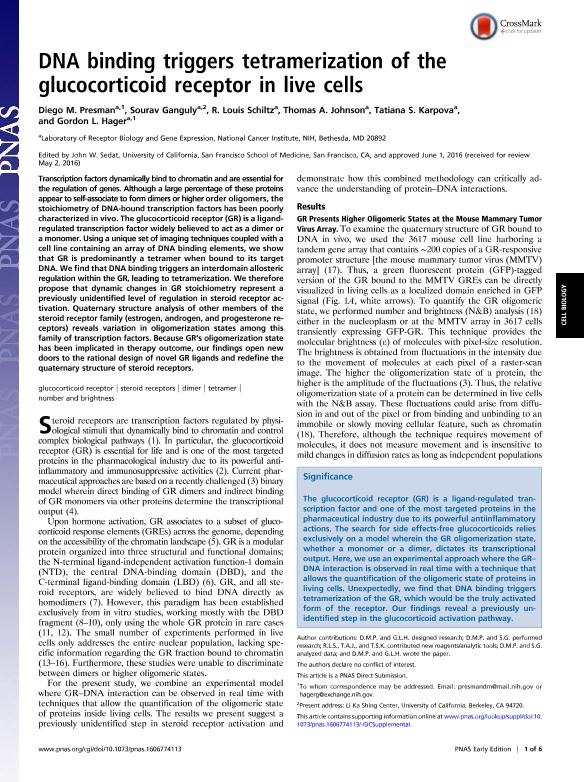Mostrar el registro sencillo del ítem
dc.contributor.author
Presman, Diego Martin

dc.contributor.author
Ganguly, Sourav
dc.contributor.author
Schiltz, R. Louis
dc.contributor.author
Johnson, Thomas A.
dc.contributor.author
Karpova, Tatiana S.
dc.contributor.author
Hager, Gordon L.
dc.date.available
2018-10-09T18:40:44Z
dc.date.issued
2016-07
dc.identifier.citation
Presman, Diego Martin; Ganguly, Sourav; Schiltz, R. Louis; Johnson, Thomas A.; Karpova, Tatiana S.; et al.; DNA binding triggers tetramerization of the glucocorticoid receptor in live cells; National Academy of Sciences; Proceedings of the National Academy of Sciences of The United States of America; 113; 29; 7-2016; 8236-8241
dc.identifier.issn
0027-8424
dc.identifier.uri
http://hdl.handle.net/11336/61991
dc.description.abstract
Transcription factors dynamically bind to chromatin and are essential for the regulation of genes. Although a large percentage of these proteins appear to self-associate to form dimers or higher order oli gomers, t he stoichiometry of DNA-bound transcription factors has been poorly characterized in vivo. The glucocorticoid receptor (GR) is a ligandregulated transcription factor widely believed to act as a dimer or a monomer. Using a unique set of imaging techniques coupled with a cell line containing an array of DNA binding elements, we show that GR is predominantly a tetramer when bound to its target DNA. We find that DNA binding triggers an interdomain allosteric regulation within the GR, leading to tetramerization. We therefore propose that dynamic changes in GR stoichiometry represent a previously unidentified level of regulation in steroid receptor activation. Quaternary structure analysis of other members of the steroid receptor family (estrogen, androgen, and progesterone receptors) reveals variation in oligomerization states among this family of transcription factors. Because GR's oligomerization state has been implicated in therapy outcome, our findings open new doors to the rational design of novel GR ligands and redefine the quaternary structure of steroid receptors.
dc.format
application/pdf
dc.language.iso
eng
dc.publisher
National Academy of Sciences

dc.rights
info:eu-repo/semantics/openAccess
dc.rights.uri
https://creativecommons.org/licenses/by-nc-sa/2.5/ar/
dc.subject
Dimer
dc.subject
Glucocorticoid Receptor
dc.subject
Number And Brightness
dc.subject
Steroid Receptors
dc.subject
Tetramer
dc.subject.classification
Otras Ciencias Biológicas

dc.subject.classification
Ciencias Biológicas

dc.subject.classification
CIENCIAS NATURALES Y EXACTAS

dc.title
DNA binding triggers tetramerization of the glucocorticoid receptor in live cells
dc.type
info:eu-repo/semantics/article
dc.type
info:ar-repo/semantics/artículo
dc.type
info:eu-repo/semantics/publishedVersion
dc.date.updated
2018-10-01T16:10:43Z
dc.journal.volume
113
dc.journal.number
29
dc.journal.pagination
8236-8241
dc.journal.pais
Estados Unidos

dc.journal.ciudad
Washington
dc.description.fil
Fil: Presman, Diego Martin. Consejo Nacional de Investigaciones Científicas y Técnicas; Argentina. National Cancer Institute; Estados Unidos
dc.description.fil
Fil: Ganguly, Sourav. National Cancer Institute; Estados Unidos
dc.description.fil
Fil: Schiltz, R. Louis. National Cancer Institute; Estados Unidos
dc.description.fil
Fil: Johnson, Thomas A.. National Cancer Institute; Estados Unidos
dc.description.fil
Fil: Karpova, Tatiana S.. National Cancer Institute; Estados Unidos
dc.description.fil
Fil: Hager, Gordon L.. National Cancer Institute; Estados Unidos
dc.journal.title
Proceedings of the National Academy of Sciences of The United States of America

dc.relation.alternativeid
info:eu-repo/semantics/altIdentifier/doi/https://dx.doi.org/10.1073/pnas.1606774113
dc.relation.alternativeid
info:eu-repo/semantics/altIdentifier/url/http://www.pnas.org/content/113/29/8236
Archivos asociados
